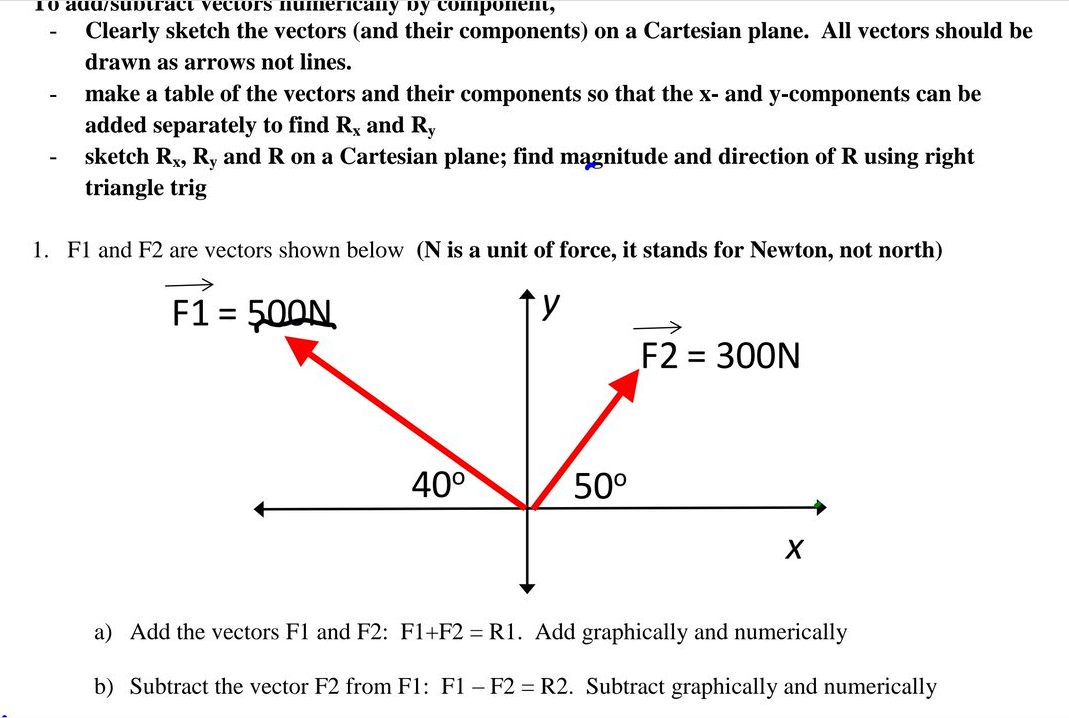10 add/SuDiract vectors numerically by conponent, Clearly sketch the vectors (and their components) on a Cartesian plane. All vectors should be drawn as arrows not lines. make a table of the vectors and their components so that the x- and y-components can be added separately to find Rx and Ry sketch Rx, Ry and R on a Cartesian plane; find mągnitude and direction of R using right triangle trig 1. F1 and F2 are vectors shown below (N is a unit of force, it stands for Newton, not north) F1 = 500N, F2 = 300N 40° 50° a) Add the vectors F1 and F2: F1+F2 = R1. Add graphically and numerically b) Subtract the vector F2 from F1: F1 – F2 = R2. Subtract graphically and numerically
10 add/SuDiract vectors numerically by conponent, Clearly sketch the vectors (and their components) on a Cartesian plane. All vectors should be drawn as arrows not lines. make a table of the vectors and their components so that the x- and y-components can be added separately to find Rx and Ry sketch Rx, Ry and R on a Cartesian plane; find mągnitude and direction of R using right triangle trig 1. F1 and F2 are vectors shown below (N is a unit of force, it stands for Newton, not north) F1 = 500N, F2 = 300N 40° 50° a) Add the vectors F1 and F2: F1+F2 = R1. Add graphically and numerically b) Subtract the vector F2 from F1: F1 – F2 = R2. Subtract graphically and numerically
Physics for Scientists and Engineers: Foundations and Connections
1st Edition
ISBN:9781133939146
Author:Katz, Debora M.
Publisher:Katz, Debora M.
Chapter3: Vectors
Section: Chapter Questions
Problem 33PQ
Related questions
Question

Transcribed Image Text:10 add/Subtraci veciors numerically by component,
Clearly sketch the vectors (and their components) on a Cartesian plane. All vectors should be
drawn as arrows not lines.
make a table of the vectors and their components so that the x- and y-components can be
added separately to find Ry and Ry
sketch Rx, Ry and R on a Cartesian plane; find mągnitude and direction of R using right
triangle trig
1. Fl and F2 are vectors shown below (N is a unit of force, it stands for Newton, not north)
>
F1 = 500N
F2 = 300N
40°
50°
a) Add the vectors F1 and F2: F1+F2 = R1. Add graphically and numerically
b) Subtract the vector F2 from F1: F1 – F2 = R2. Subtract graphically and numerically
Expert Solution
This question has been solved!
Explore an expertly crafted, step-by-step solution for a thorough understanding of key concepts.
Step by step
Solved in 2 steps with 2 images

Knowledge Booster
Learn more about
Need a deep-dive on the concept behind this application? Look no further. Learn more about this topic, physics and related others by exploring similar questions and additional content below.Recommended textbooks for you

Physics for Scientists and Engineers: Foundations…
Physics
ISBN:
9781133939146
Author:
Katz, Debora M.
Publisher:
Cengage Learning

Physics for Scientists and Engineers with Modern …
Physics
ISBN:
9781337553292
Author:
Raymond A. Serway, John W. Jewett
Publisher:
Cengage Learning

University Physics Volume 1
Physics
ISBN:
9781938168277
Author:
William Moebs, Samuel J. Ling, Jeff Sanny
Publisher:
OpenStax - Rice University

Physics for Scientists and Engineers: Foundations…
Physics
ISBN:
9781133939146
Author:
Katz, Debora M.
Publisher:
Cengage Learning

Physics for Scientists and Engineers with Modern …
Physics
ISBN:
9781337553292
Author:
Raymond A. Serway, John W. Jewett
Publisher:
Cengage Learning

University Physics Volume 1
Physics
ISBN:
9781938168277
Author:
William Moebs, Samuel J. Ling, Jeff Sanny
Publisher:
OpenStax - Rice University

Principles of Physics: A Calculus-Based Text
Physics
ISBN:
9781133104261
Author:
Raymond A. Serway, John W. Jewett
Publisher:
Cengage Learning

Physics for Scientists and Engineers
Physics
ISBN:
9781337553278
Author:
Raymond A. Serway, John W. Jewett
Publisher:
Cengage Learning

College Physics
Physics
ISBN:
9781305952300
Author:
Raymond A. Serway, Chris Vuille
Publisher:
Cengage Learning